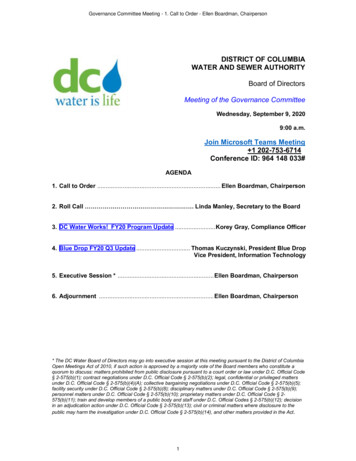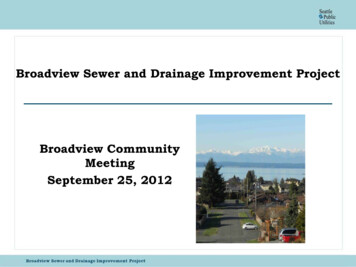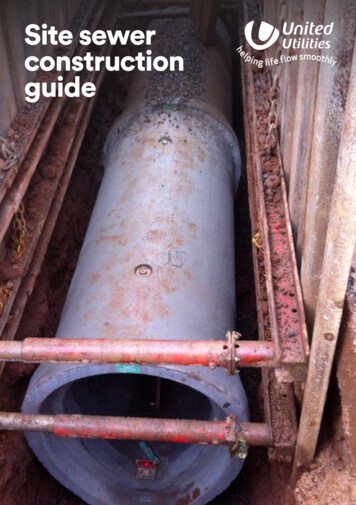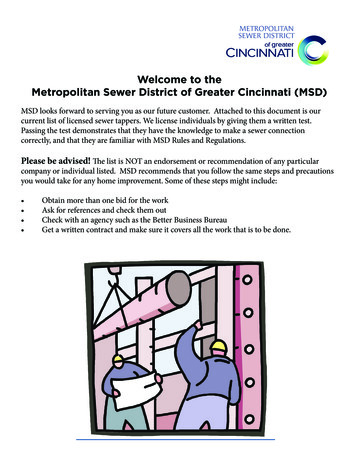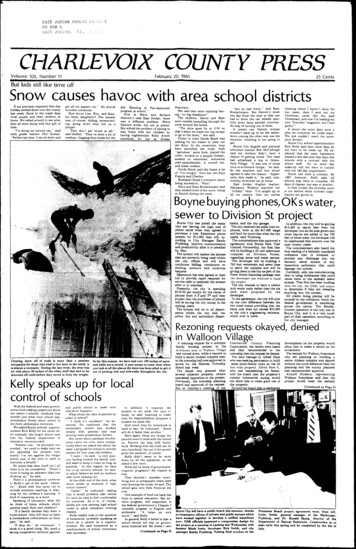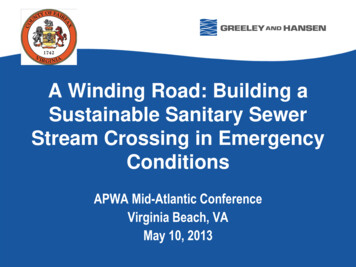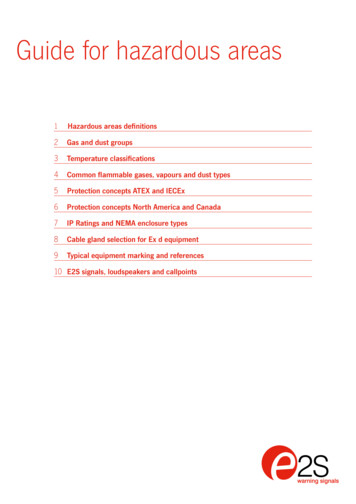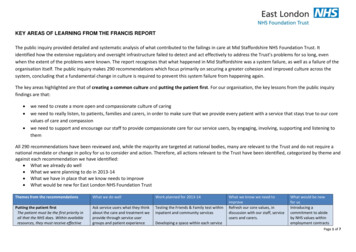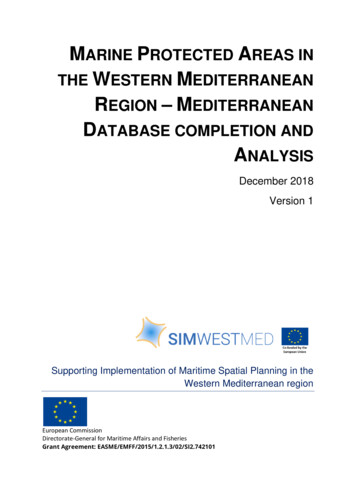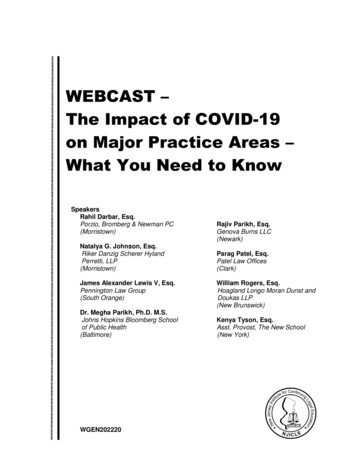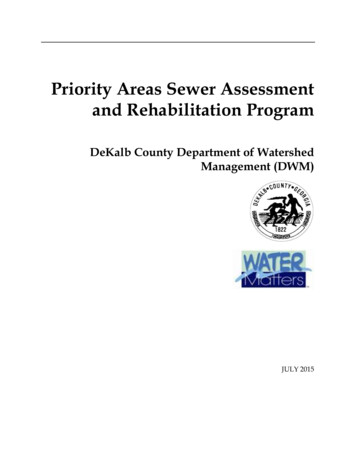
Transcription
Priority Areas Sewer Assessmentand Rehabilitation ProgramDeKalb County Department of WatershedManagement (DWM)JULY 2015
DEKALB COUNTYDEPARTMENT OF WATERSIDE MANAGEMENTPASARPJULY 2015CONTENTSCONTENTS . iACRONYMS . iii123INTRODUCTION . 11.1Overview . 11.2Description of the DeKalb County WCTS . 21.3WCTS Condition and Context of the PASARP . 3PRIORITY AREAS IDENTIFICATION, DELINEATION, ANDPRIORITIZATION . 52.1Initial Priority Areas Identification . 52.2Additional Priority Areas Identification, Delineation, and Prioritization . 75Description of the Criteria Used to Identify, Delineate, andPrioritize Additional Priority Areas . 72.2.2Additional Priority Areas Identification, Delineation, andPrioritization Process. 10SPECIFICATIONS, GUIDELINES, AND PROCEDURES FOR EVALUATIVETOOLS AND PROGRAMS . 153.142.2.1Overview of WCTS Evaluative Tools and Programs and theirApplicability to the PASARP . 15CRITERIA FOR IDENTIFYING AND PRIORITIZING REHABILITATIONMEASURES . 184.1Identification and Prioritization of Rehabilitation Measures . 184.2Procedures for Tracking and Inventorying Completed RehabilitationMeasures . 204.3Key Performance Indicators (KPIs) for Determining the Effectiveness ofCompleted Rehabilitation Measures within Priority Areas. 21SCHEDULE FOR COMPLETING REHABILITATION MEASURES WITHIN THEINITIAL AND ADDITIONAL PRIORITY AREAS . 225.1Priority Areas Assessment and Rehabilitation Master Schedule . 225.2Project Schedules. 235.3General Schedule . 23i
DEKALB COUNTYDEPARTMENT OF WATERSIDE MANAGEMENTPASARPJULY 2015AppendicesA. Initial Priority Areas Map.B. Additional Priority Areas Identification, Delineation, and Prioritization Process.C. Additional Priority Areas Map.D. Private Lateral Investigations Specifications, Guidelines, and Procedures.E. Dyed Water Flooding Specifications, Guidelines, and Procedures.F. Corrosion Defect Identifications Specifications, Guidelines, and Procedures.G. Manhole Condition Assessment Specifications, Guidelines, and Procedures.H. Flow Monitoring Specifications, Guidelines, and Procedures.I.Closed Circuit Television (“CCTV”) Inspection Specifications, Guidelines, andProcedures.J.Gravity Sewer Line and Force Main Defect Analysis Specifications, Guidelines, andProcedures.K. Smoke Testing Specifications, Guidelines, and Procedures.L. Scheduled Assessment and Rehabilitation Measures within the Initial and AdditionalPriority Areas.M. General Schedule for Completing Additional Assessment and/or PrioritizedRehabilitation Measures within the Initial and Additional Priority Areas.LIST OF TABLESTable 2-1 . List of Priority Areas . 6Table 2-2 . Weights Assigned to Various Criteria . 12Table 2-3 . List of Additional Priority Areas . 14Table 4-1 . Initial and Additional Priority Areas KPIs . 21ii
DEKALB COUNTYDEPARTMENT OF WATERSIDE MANAGEMENTPASARPJULY 2015ACRONYMSASCEAmerican Society of Civil EngineersAWTFAdvanced Wastewater Treatment FacilityCCTVClosed Circuit TelevisionCERPContingency and Emergency Response PlanCIPPCured in Place Pipe LiningC&MDeKalb County Department of Watershed Management Construction andMaintenance DivisionCMMSComputerized Maintenance Management SystemCMOMCapacity, Management, Operations, and MaintenanceDWMDeKalb County Department of Watershed ManagementFOGFats, Oil, and GreaseEPAU.S. Environmental Protection AgencyEPDGeorgia Environmental Protection DivisionGAWPGeorgia Association of Water ProfessionalsGISGeographical Information SystemGWEFGeorgia Water Environment FederationI/IInfiltration/InflowKPIKey Performance IndicatorsMACPManhole Assessment and Certification ProgramNPDESNational Pollutant Discharge Elimination SystemNACWANational Association of Clean Water AgenciesNASSCONational Association of Sewer Service CompaniesO&MOperation and MaintenanceOSARPOngoing Sewer Assessment and Rehabilitation ProgramPACPPipeline Assessment and Certification ProgramPASARPPriority Areas Sewer Assessment and Rehabilitation ProgramRDI/IRainfall Dependent Infiltration/Inflowiii
DEKALB COUNTYDEPARTMENT OF WATERSIDE MANAGEMENTPASARPJULY 2015ROWRights-of WaySSESSewer System Evaluation SurveySOPStandard Operating ProceduresSSOSSanitary Sewer OverflowsWCTSWastewater Collection and Transmission Systemiv
1 INTRODUCTION1.1 OverviewThis Priority Areas Sewer Assessment and Rehabilitation Program (PASARP) has beenprepared in accordance with the requirements of Section VI.B(x).35 of the Consent Decree DeKalb County, Civil Action File No. 1:10-CV-4039-WSD. Section VI.B(x).35 of the ConsentDecree requires the County to submit the PASARP to the U.S. Environmental ProtectionAgency (EPA) and the Georgia Environmental Protection Division (EPD), for review andcomment, within one (1) year of the Date of Entry of the Consent Decree. The ConsentDecree was entered on December 20, 2011.The main purpose of the PASARP is to provide for the identification, delineation,assessment, prioritization, and rehabilitation of Priority Areas (both Initial Priority Areasand Additional Priority Areas as explained in the Consent Decree) within the DeKalbCounty Wastewater Collection and Transmission System (WCTS). The Initial andAdditional Priority Areas total approximately 776 miles of sewers (approximately 29.5 % ofthe WCTS). In implementing the PASARP, the County will undertake certain condition,structural, and hydraulic assessments within the Priority Areas, and identify, prioritize, andcomplete appropriate rehabilitation measures within those areas. As part of theimplementation process, the County will track and inventory rehabilitation measurescompleted within the Priority Areas and determine the effectiveness of those measures,using selected key performance indicators (KPIs). The County will completeimplementation of the PASARP within eight and one-half (8½) years from the Date of Entryof the Consent Decree. The County has hired an outside contractor experienced in managingthe implementation of Consent Decree sewer system improvement programs to assist it inthe implementation of the PASARP in the capacity of a Program Manager.This document contains the following key elements in compliance with the requirements ofSection VI.B(x).35 of the Consent Decree: List and map of the Initial Priority Areas identified in the Consent Decree. Schedule for completing sewer assessment and for identifying, prioritizing, andcompleting rehabilitation projects within the Initial Priority Areas. List and map of Additional Priority Areas identified after the Date of Entry of theConsent Decree, including an explanation of how the County identified, delineated,and prioritized the Additional Priority Areas. Specifications, guidelines, and procedures, as appropriate, for the followingevaluative tools and programs that will be used during the assessment of the Initialand Additional Priority Areas: Private Lateral Investigations. Dyed Water Flooding.1
DEKALB COUNTYDEPARTMENT OF WATERSIDE MANAGEMENTPASARPJULY 2015 Corrosion Defect Identifications. Manhole Condition Assessment. Flow Monitoring. Closed Circuit Television (“CCTV”) Inspection. Gravity Sewer Line and Force Main Defect Analysis. Smoke Testing. Criteria for identifying and prioritizing rehabilitation measures to be implementedwithin the Priority Areas. Procedures for tracking and inventorying completed rehabilitation measurescompleted within the Priority Areas, including key performance indicators (KPIs). List of currently scheduled rehabilitation measures within the Priority Areas.1.2 Description of the DeKalb County WCTSThe DeKalb County WCTS (defined to include all pipes, lift stations, force mains, gravitysewer lines, manholes and other appurtenances) consists of an estimated 2,600 miles ofsewers, 66 lift stations, and an estimated 61,500 manholes. The County is divided into three(3) sewer basins (Intergovernmental, Snapfinger, and Pole Bridge) containing a total ofthirty-five (35) sewersheds, two (2) of which do not currently contain any sewers. Thefollowing are summary descriptions of the three (3) sewer basins: Inter-Governmental Basin: The Intergovernmental Basin is divided into the followingnine (9) sewersheds: Ball Mill Creek, Camp Creek, Lucky Shoals Creek, MarshCreek, Northeast Creek, Nancy Creek, North Fork Creek, South Fork Creek, andPeavine Creek. This basin contains an estimated 1,136 miles of sanitary sewers andan estimated 25,800 manholes.The approximately thirty-six (36) million gallons per day (MGD) of wastewatergenerated within the Intergovernmental Basin is collected, transmitted, and treatedat the City of Atlanta R. M. Clayton Water Reclamation Facility under anintergovernmental agreement with the City of Atlanta. Sewers located within theCity of Atlanta, through which wastewater from the Intergovernmental Basin flows,are owned and maintained by the City of Atlanta under the above-mentionedintergovernmental agreement with the City of Atlanta. Snapfinger Basin: This basin is divided into the following fifteen (15) sewersheds:Barbashela Creek, Blue Creek, Cobb Fowler Creek, Conley Creek, Constitution Area,Corn Creek, Doolittle Creek, Indian Creek, Intrenchment Creek, Lower SnapfingerCreek, Shoal Creek, South River, Sugar Creek, Upper Snapfinger Creek, and UpperStone Mountain. This basin contains an estimated 1,098 miles of sanitary sewersand an estimated 25,100 manholes.2
DEKALB COUNTYDEPARTMENT OF WATERSIDE MANAGEMENTPASARPJULY 2015There are two (2) areas served by septic tanks only in the Snapfinger Basin. Theseareas include approximately one-third (⅓) of the Cobb Fowler Creek sewershed andthe entire Upper Stone Mountain sewershed. Pole Bridge Basin: The Pole Bridge Basin is divided into the following eleven (11)sewersheds: Crooked Creek, Honey Creek, Johnson Creek, Lower Crooked Creek,Lower Stone Mountain, Pine Mountain Creek, Plunket Creek, Polebridge Creek,Swift Creek, Upper Crooked Creek, and Yellow River. This basin includes anestimated 398 miles of sanitary sewer and an estimated 10,600 manholes.1.3 WCTS Condition and Context of the PASARPIn order to promote effective operation and longevity of its WCTS, the County maintains anassortment of equipment and a diverse group of personnel to perform both proactive andreactive maintenance work twenty-four (24) hours per day. In addition to its inventory ofequipment and personnel resources, the County has developed and continues to improveand implement Capacity, Management, Operations, and Maintenance (CMOM) programscountywide. Specifically, and as a part of its Consent Decree obligations, the County isimplementing the following CMOM programs: Contingency and Emergency Response Plan. Fats, Oils, and Grease Management Program. Sewer Mapping Program. Maintenance Management Systems Program. Collection and Transmission System Training Program. System-Wide Flow and Rainfall Monitoring Program. System-Wide Hydraulic Model. Financial Analysis Program. Infrastructure Acquisitions Program.In addition to the above programs, and also separate from the PASARP, the County isrequired to implement an Ongoing Sewer Assessment and Rehabilitation Program(”OSARP”) that will ensure continuous assessment and rehabilitation of the County’sWCTS. The OSARP will begin its focus on areas outside the Initial and Additional PriorityAreas. However, this program is intended to be maintained on a permanent basis by theCounty. In effect, the entire WCTS will be continuously assessed and rehabilitated.The PASARP focuses on a subset of the WTCS, the areas potentially needing more urgentattention, hence the term Priority Areas. As noted, these Priority Areas are estimated to beabout 30.2% of the WCTS based on the updated Priority Area boundary delineation surveysrequired by the Consent Decree. Because of the relatively young age of the County’s WCTS(84% of the WCTS is less than 50 years old), the extent of the County’s ongoing proactiveand reactive maintenance program, and the CMOM Programs, the County’s WCTS is in3
DEKALB COUNTYDEPARTMENT OF WATERSIDE MANAGEMENTPASARPJULY 2015relatively good condition. For instance, for the last several years, the County has beenassessing the condition of its manholes (Manhole Condition Assessment) and rankingobserved manhole structural defects using the assessment contractor’s own list of defectcodes. The PASARP manhole condition assessments now require the assessmentcontractor’s defect coding to be based on the National Association of Sewer ServiceCompanies (NASSCO) Manhole Assessment and Certification Program (MACP) and aNASSCO compliant standard exchange database with the coding results to be submitted tothe County. Based on the results of the Manhole Condition Assessment performed to date,more than ninety percent (90%) had no structural defects. Similarly, in 2010, the Countyevaluated a representative portion of its WCTS for Excessive infiltration and inflow (I/I)and found that the average “R-Value” for all the meters analyzed was approximately 1.7%;indicating that the County’s WCTS experiences a relatively insignificant amount of I/Iduring periods of wet weather. Nonetheless, the CMOM Programs, the PASARP, and theOSARP, while individually addressing different aspects of the WCTS, will together ensurethe long-term viability of the WCTS and eliminate SSOs.4
DEKALB COUNTYDEPARTMENT OF WATERSIDE MANAGEMENTPASARPJULY 20152 PRIORITY AREAS IDENTIFICATION,DELINEATION, AND PRIORITIZATION2.1 Initial Priority Areas IdentificationAs part of the Consent Decree, the County identified twenty-three (23) Initial Priority Areaswithin its WCTS for further assessment and rehabilitation. The Initial Priority Areas consistsof areas determined by the County as having sewers that are estimated to be older than fifty(50) years; areas with calculated “R-Values” greater than three (3) percent; and areasdetermined by the County, through its ongoing sewer system maintenance program, asneeding additional assessment and/or prioritized rehabilitation. The Initial Priority Areasconstitute approximately 463 miles of sewers, which is approximately eighteen percent(18%) of the County’s WCTS. Table 2-1 presents a list of the Initial Priority Areas includingsummary descriptions of each numbered Initial Priority Area, estimated length of eachInitial Priority Area, and the name of the basin where each Initial Priority Area is located.Appendix A presents a map showing the locations of each numbered Initial Priority Area. Itshould be noted that a new numbering system for the Priority Areas has been adopted bythe County. The first letter in the Priority Areas numbers identifies whether the PriorityArea is an Initial Priority Area (I) or an Additional Priority Area (A). The second two lettersidentifies the sewer basin where the Priority Area is located (IG for the IntergovernmentalBasin, SF for the Snapfinger Basin, and PB for the Pole Bridge)5
DEKALB COUNTYDEPARTMENT OF WATERSIDE MANAGEMENTPASARPJULY 2015Table 2-1List of Initial Priority AreasConsentDecreeNumberNewPriority 19Area DescriptionINTER-GOVERNMENTAL BASINWinters Chapel Rd at Homeland DriveCarver CircleAshford Dunwoody-Nancy CreekNorth Peachtree-North ShallowfordOakcliff RoadCity of ChambleeEmbry Circle Pipe BurstingEmbry Circle ReliningWindsor ParkwayDrew Valley Road subdivisionsSkyland RoadHenderson Mill RdArea contributing to TSFORK 5 monitorBriarcliff RdLavista - Oak Grove areaLavista Rd-Clairmont Rd-Houston Mill RdNorth DeKalb Mall areaScott Blvd-Clairmont RdOld Rockbridge Rd-Avondale (partial)SUBTOTAL:Length ofSewers( LF NGER BASINOld Rockbridge Rd-Avondale (partial)Cobb Fowler BasinShoal Creek BasinCovington Hwy at Kensington 1POLE BRIDGE BASINLithonia Industrial PkwySUBTOTAL:22,77322,7736
DEKALB COUNTYDEPARTMENT OF WATERSIDE MANAGEMENTPASARPJULY 20152.2 Additional Priority Areas Identification,Delineation, and PrioritizationSubparagraphs 35(b) and 35(c) of Section VI.B(x) of the Consent Decree requires the Countyto identify Additional Priority Areas within the County’s WCTS for further assessment andrehabilitation and to provide an explanation of how the Additional Priority Areas wereidentified, delineated, and prioritized. Subparagraph 35(d) of Section VI.B.(x) of the ConsentDecree lists the criteria for identifying, delineating, and prioritizing the Additional PriorityAreas. Section 2.2.1 of this document provides summary descriptions of the criteria used toidentify, delineate, and prioritize Additional Priority Areas. Section 2.2.2 provides asummary of the process followed during the identification, delineation, and prioritization ofthe Additional Priority Areas. The details regarding the Additional Priority Areasidentification, delineation, and prioritization process, including how the criteria wereapplied, are included in a report titled “DeKalb County Department of WatershedManagement Wastewater Collection and Transmission System (WCTS) Additional PriorityAreas Identification, Delineation, and Prioritization Process”, which is included inAppendix B of this document. The Additional Priority Areas constitute approximately 313miles of sewers, which is approximately 12% of the County’s WCTS.2.2.1 Description of the Criteria Used to Identify, Delineate, andPrioritize Additional Priority AreasThe following are summary descriptions of the criteria used to identify, delineate, andprioritize Additional Priority Areas: Relative Age of the WCTS Infrastructure: Three (3) age categories were identified anddelineated in the County’s GIS: (1) sewers installed prior to and including the year1960, sewers installed between the time period of 1961 t
required to implement an Ongoing Sewer Assessment and Rehabilitation Program (”OSARP”) that will ensure continuous assessment and rehabilitation of the County’s WCTS. The OSARP will begin its focus on areas outside the Initial and Additional Priority Areas. However, this program is intended to be maintained on a permanent basis by the County.
